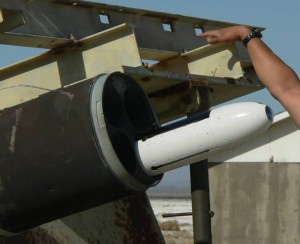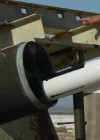MBDA Inc. successfully demonstrates guidance and control

Westlake Village, California. MBDA Inc. today announced the successful demonstration of a Semi-Active Laser Guided Zuni rocket at the Navy’s test facilities at China Lake, CA. utilizing the WGU-58/B Guidance and Control System developed in cooperation with the Naval Air Warfare Center Weapons Division (NAWCWD).
Jim Pennock, Vice President of Guided Rocket Sector Business Development at MBDA Inc. said “The WGU-58/B Guidance and Control system performed as predicted. We developed this capability in response to a U.S. Marine Corps need for a forward-firing, low-cost, semi-active laser guided weapon capable of accurately engaging fixed and moving targets in close proximity to friendly forces, while allowing firing aircraft to remain outside the threat envelope. Our successful team includes the NAWCWD, China Lake and our industry partners; Elbit Systems of America, Fort Worth TX; General Dynamics, Healdsburg CA; and Honeywell, Minneapolis MN”.
The design concept maximizes the use of off-the-shelf hardware and software, and does not require changes to the aircraft interface to employ the weapon, thereby permitting the rapid transition of the hardware into the inventory. The design allows the WGU-58/B guidance and control system to be easily attached to the existing Zuni rockets in the field.
The Zuni is fired from the LAU-10 launcher, which is a pod that is carried on a fighter aircraft’s weapon station. The pod is designed to carry and fire four Zuni rockets which gives the aircraft an immediate increase in the number of targets that it can engage over most of the other semi-active laser guided weapons of a comparable warhead effectiveness which are limited to one or two per weapon station.
The high speed profile of the weapon will permit tactical aircraft using existing targeting pods to rapidly and accurately engage a target while staying outside the range of an enemy’s weapons. The WGU-58/B Guidance and Control system can provide an immediate precision guided weapon capability to any aircraft capable of carrying the LAU-10 pod.

Westlake Village, Californie. MBDA Inc. annonce le succès du tir d’une roquette équipée du système de guidage laser semi-actif WGU-58/B développé en coopération avec la division armement du centre militaire aéronaval (NAWCWD). Ce tir a été réalisé dans les installations de l’US Navy à China Lake, en Californie.
Jim Pennock, Vice-président du Business Developpement du secteur Roquettes Guidées chez MBDA Inc. a déclaré : « le système de contrôle et de guidage the WGU-58 a fonctionné comme prévu. Nous avons développé cette capacité en réponse au besoin exprimé par le corps des Marines pour une arme guidée par laser, peu coûteuse, capable d’engager précisément des cibles fixes ou mobiles à proximité immédiate de troupes amies, tout en permettant à l’avion tireur de rester à distance de sécurité. Notre équipe inclut le NAWCWD, China Lake et nos partenaires industriels : Elbit Systems of America, Fort Worth TX, General Dynamics, Healdsburg CA et Honeywell, Minneapolis MN.
Les principes de conception maximisent l’utilisation de matériels et logiciels « sur étagère », et ne requiert pas de changement dans l’interface de l’avion, ce qui permet ainsi de passer rapidement de la phase de développement à la phase opérationnelle. Le système de contrôle et de guidage WGU-58/B s’adapte aisément aux roquettes Zuni existantes.
Le Zuni est tiré depuis le lanceur LAU-10, qui est une nacelle fixée aux points d’emports d’armement des avions de combats. La nacelle est conçue pour porter et tirer 4 roquettes Zuni, ce qui permet à l’avion d’engager un nombre plus importants de cibles qu’avec les autres armes à guidage laser semi-actif de puissance comparable, qui sont limitées à un ou deux par points d’emports.
La grande vitesse de l’arme permettra à des avions existants d’engager rapidement et précisément une cible tout en restant hors de portée des armes ennemies. Le système de contrôle et de guidage WGU-58/B fournit une capacité immédiate de guidage laser à tout type d’avion capable de porter la nacelle LAU-10.

Westlake Village, Kalifornien. MBDA Inc. gab heute die erfolgreiche Vorführung einer mit halbaktivem Laser gelenkten Zuni-Rakete auf dem Testgelände der US-Marine am China Lake, CA. bekannt. Dabei kam das Lenk- und Steuerungssystem WGU-58/B zum Einsatz, welches in Zusammenarbeit mit der Naval Air Warfare Center Weapons Division (NAWCWD) entwickelt wurde.
Jim Pennock, Vice President Business Development des Bereichs „Guided Rocket“ bei MBDA Inc., erklärte: “Das Lenk- und Steuerungssystem WGU-58/B hat die Erwartungen erfüllt. Wir haben diese Fähigkeit als Antwort auf den Bedarf des US-Marine Corps entwickelt. Diese benötigt einen nach vorn abfeuernden, kostengünstigen, mit halbaktivem Laser gelenkten Flugkörper, der feststehende und fahrende Ziele in unmittelbarer Nähe zu eigenen Einheiten präzise bekämpfen kann, während das abfeuernde Flugzeug außer Reichweite der Bedrohung bleiben kann. Unser erfolgreiches Team schließt die NAWCWD, China Lake, sowie unsere folgenden Industriepartner ein: Elbit Systems of America, Fort Worth TX; General Dynamics, Healdsburg CA; und Honeywell, Minneapolis MN.“
Das Konstruktionskonzept ermöglicht die weitgehende Verwendung von handelsüblicher Hard- und Software und macht für den Einsatz der Wafffe keine Änderungen an der Flugzeug-Schnittstelle erforderlich. Hiermit wird ein schneller Übergang der Hardware in den Bestand möglich. Aufgrund der Konstruktion kann das Lenk- und Steuerungssystem WGU-58/B problemlos an der vorhandenen Zuni-Rakete angebracht werden.
Die Zuni wird vom Werfer LAU-10 abgefeuert, ein Behälter, der in die Waffenstation des Kampfflugzeugs integriert ist. Der Behälter ist für die Aufnahme und das Abfeuern von vier Zuni-Rakten ausgelegt. Dies gestattet dem Kampfjet mehr Ziele zu bekämpfen, als die meisten anderen per halbaktivem Laser gelenkten Waffen mit vergleichbarer Gefechtskopf-Effizienz, da diese pro Waffenstation auf ein oder zwei beschränkt sind.
Die hohe Geschwindigkeit der Waffe erlaubt es taktischen Flugzeugen mit vorhandenen Zielvorrichtungen, Ziele schnell und präzise zu bekämpfen und dabei außerhalb der Reichweite feindlicher Waffen zu bleiben. Das Lenk- und Steuerungssystem WGU-58/B versieht jedes Flugzeug, das mit dem Werfer LAU-10 ausgerüstet wird, sofort mit einer Präzisions-Lenkwaffenfähigkeit.

Westlake Village, California. MBDA Inc. ha oggi effettuato con successo un tiro dimostrativo del razzo Zuni guidato con la funzionalità SAL (Semi-Active Laser) effettuato presso gli impianti di collaudo della Marina militare statunitense a China Lake, in California. Per la dimostrazione è stato utilizzato il sistema di guida e controllo WGU-58/B, sviluppato in collaborazione con la NAWCWD (Naval Air Warfare Center Weapons Division).
Jim Pennock, Vice Presidente del reparto Guided Rocket Sector Business Development presso MBDA Inc. ha affermato che “Il sistema di guida e controllo WGU-58/B si è comportato come previsto. Abbiamo sviluppato questa funzionalità in risposta all’esigenza dell’USMC di un’arma da tiro frontale a basso costo guidata da un laser semiattivo in grado di attaccare con precisione bersagli statici e in movimento in prossimità di forze amiche, consentendo al tempo stesso all’aeromobile di rimanere al di fuori del raggio di pericolo. Fanno parte del team la divisione NAWCWD di China Lake e i nostri partner di settore: Elbit Systems of America, Fort Worth Texas; General Dynamics, Healdsburg California; Honeywell, Minneapolis Minnesota.”
Il sistema utilizza al massimo il materiale e il software commerciale standard e non necessita alcuna modifica all’interfaccia dell’aeromobile per l’impiego dell’arma, consentendo una rapida transizione dell’hardware nell’inventario. Grazie al progetto, il sistema di guida e controllo WGU-58/B può essere collegato in modo semplice ai razzi Zuni esistenti nel campo.
Lo Zuni viene tirato dal lanciatore LAU-10, un pod posizionato sulla stazione missilistica di un caccia da combattimento. Il pod è progettato per il trasporto e il lancio di quattro razzi Zuni, permettendo all’aeromobile un aumento immediato del numero di bersagli attaccabili rispetto alla maggior parte delle altre armi ad auto-guida laser semiattiva aventi pari efficacia in termini di carica militare, che sono limitate ad una o due armi per ciascuna stazione missilistica.
Il profilo ad elevata velocità dell’arma permetterà agli aeromobili tattici che utilizzano pod di designazione bersagli esistenti, di attaccare rapidamente e con precisione i bersagli, rimanendo al di fuori del raggio d’azione delle armi nemiche. Il sistema di guida e controllo WGU-58/B fornisce istantaneamente una capacità di guida d’arma estremamente precisa, a tutti gli aeromobili in grado di trasportare il pod LAU-10.




